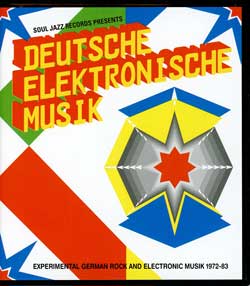Review: Various Artists, Deutsche Elektronische Musik
 Deutsche Elektronische Musik is a two disc collection from Soul Jazz Records. The set’s subtitle, Experimental German Rock and Electronic Musik 1972-83, provides an accurate description of what it’s all about. English-speaking listeners may be familiar with the term “Krautrock” as a category for this music. As explained in the excellent booklet that accompanies the collection “Krautrock” was a name coined by the UK music press that many of the practitioners of the music found offensive. Whatever you want to call it, Deutsche Elektronische Musik is a superb collection.
Deutsche Elektronische Musik is a two disc collection from Soul Jazz Records. The set’s subtitle, Experimental German Rock and Electronic Musik 1972-83, provides an accurate description of what it’s all about. English-speaking listeners may be familiar with the term “Krautrock” as a category for this music. As explained in the excellent booklet that accompanies the collection “Krautrock” was a name coined by the UK music press that many of the practitioners of the music found offensive. Whatever you want to call it, Deutsche Elektronische Musik is a superb collection.
Today the most well known bands from this period of German music are probably Can, Neu!, Faust and Tangerine Dream, all of whom are represented in Deutsche Elektronische Musik, and, of course, Kraftwerk, which is not. I assume Kraftwerk’s absence stems from licensing issues. If so, whoever is responsible for deciding not to allow Kraftwerk to appear on Deutsche Elektronische Musik made a mistake because the set is not only excellent but likely to become definitive. Kraftwerk really should be here.
In addition to the aforementioned, Deutsche Elektronische Musik includes selections by Popul Vuh, Amon Duul II, Michael Bundt, Kollective, Cluster, Ash Ra Temple and Ibliss among others.
Deutsche Elektronische Musik comes with a 35 page booklet that is very well done. Along with pictures and short biographies of the different bands it includes an excellent essay about the social, political and cultural conditions that gave birth to and shaped this music. This isn’t the kind of pompous airy-fairy sociological theorizing about the symbolic relationships between music and culture written by people who wouldn’t have a clue about how to actually gather and evaluate evidence pro and con about the ideas they are blathering on about that is characteristic of a lot of writing about popular forms of music. It is a clear headed description of social, political and cultural conditions in Germany in the 1960s and how these circumstances were viewed by many young Germans at the time. The essay provides valuable context with which to listen to the music.
It also raises some questions about how well Deutsche Elektronische Musik may serve as a survey of the music created by these bands. The key lies in the dates – 1972 to 1983. Many of these bands began their musical careers either before 1972 or before the date of their song which is included on Deutsche Elektronische Musik. Some of the early work of these bands was created from the theoretical viewpoint that politics, culture and art, including music, was so shattered and corrupted that the solution was to begin anew with something completely different. The essay in the booklet gives a compelling description of the conditions in Germany that produced the degree of alienation that gave rise to this type of view among these German musicians. Many turned to the musique concrete movement along with the music and teaching of Karlheinz Stockhausen. The result was music that is easily perceived as harsh and demanding or as nonmusical noise.
The people at Soul Jazz have not included these works in their survey of German electronic and rock music and they give fair warning of this with the dates given in the collection’s subtitle. While this may count against Deutsche Elektronische Musik as an even-handed and thorough survey of the music, it has resulted in two discs worth of very musical selections that are a joy to listen to. Once these bands had purged their need to destroy established forms and genres with noise they turned to building musical compositions using new technologies and new types of arrangements. The result, as is amply evidence on Deutsche Elektronische Musik, was a wealth of terrific music that is highly listenable.
A good deal of the music on Deutsche Elektronische Musik owes a strong debt to the psychedelic rock that was pioneered by the San Francisco bands in the mid to late 1960s. In some cases, such as Ash Ra Temple’s “Daydream” which sounds like Jefferson Airlane with a different style of female vocalist, the connection to the Haight Ashbury bands is obvious. In others, like the extended psychedlic jams represented by Ibliss’ “High Life” or Neu!’s “Hallogallo” the connection is more one of spirit than mimicry. In all of these cases the resulting music is great.
It may be difficult at first for modern listeners to hear the “electronic” in this experimental electronic music. The 1970s were the early days of portable synthesizers and their sound, and more importantly the range of sound they were capable of producing, was primitive by today’s standards. Synthesized sound has become so essential a part of current music that it can be difficult to hear how different and experimental some of these timbres sounded in the mid 1970s. It may not sound like it to modern ears, but these German bands were blazing new trails in the sounds that could be used to make music.
That’s not true of everything to be heard on Deutsche Elektronische Musik. Michael Bundt’s amazing “La Chasse Aux Microbes” is obviously synthesized music that still sounds intriguing 30 years later and Tangerine Dream’s “No Man’s Land” is a fine example of their “Cosmic music” that introduced many to the new musical possibilities inherent in synthesized sounds.
There’s so much good music on Deutsche Elektronische Musik it’s hard to pick out one track or another for special mention. Popul Vuh’s “Aguirre 1” from the soundtrack of Wernor Herzog’s film Aguirre, The Wrath of God is likely to stop you dead in your tracks with it’s profound and compelling combination of choral singing and electronic keyboards. Conrad Schnitzler’s “Auf Dem Schwarzen Canal” is one of the best “Kraftwerk” tunes not done by Kraftwerk I’ve yet to hear. Gila’s “This Morning” is lovely, sunny power pop. Kollectiv’s “Rambo Zambo” is a flute-driven psychedelic rock-out. The list could go on and on.
Deutsche Elektronische Musik is an exceptionally good collection. If you enjoy the type of psychedelic rock that was being played in the late 1960s, you will thoroughly enjoy this album. If you like electronic music there is a great deal here you will enjoy. If you like musical creativity unfettered by traditional forms and structures and songs that reflect the joy and excitement the musicians felt in playing them, Deutsche Elektronische Musik is not to be missed. Highly recommended.
Kollectiv’s “Rambo Zambo”
and Popul Vuh’s “Aguirre 1” from Deutsche Elektronische Musik
-
Archives
- August 2011 (1)
- January 2011 (1)
- October 2010 (1)
- September 2010 (1)
- August 2010 (6)
- July 2010 (20)
- June 2010 (36)
- May 2010 (10)
- April 2010 (9)
- March 2010 (6)
- November 2009 (1)
- March 2009 (1)
-
Categories
-
RSS
Entries RSS
Comments RSS
